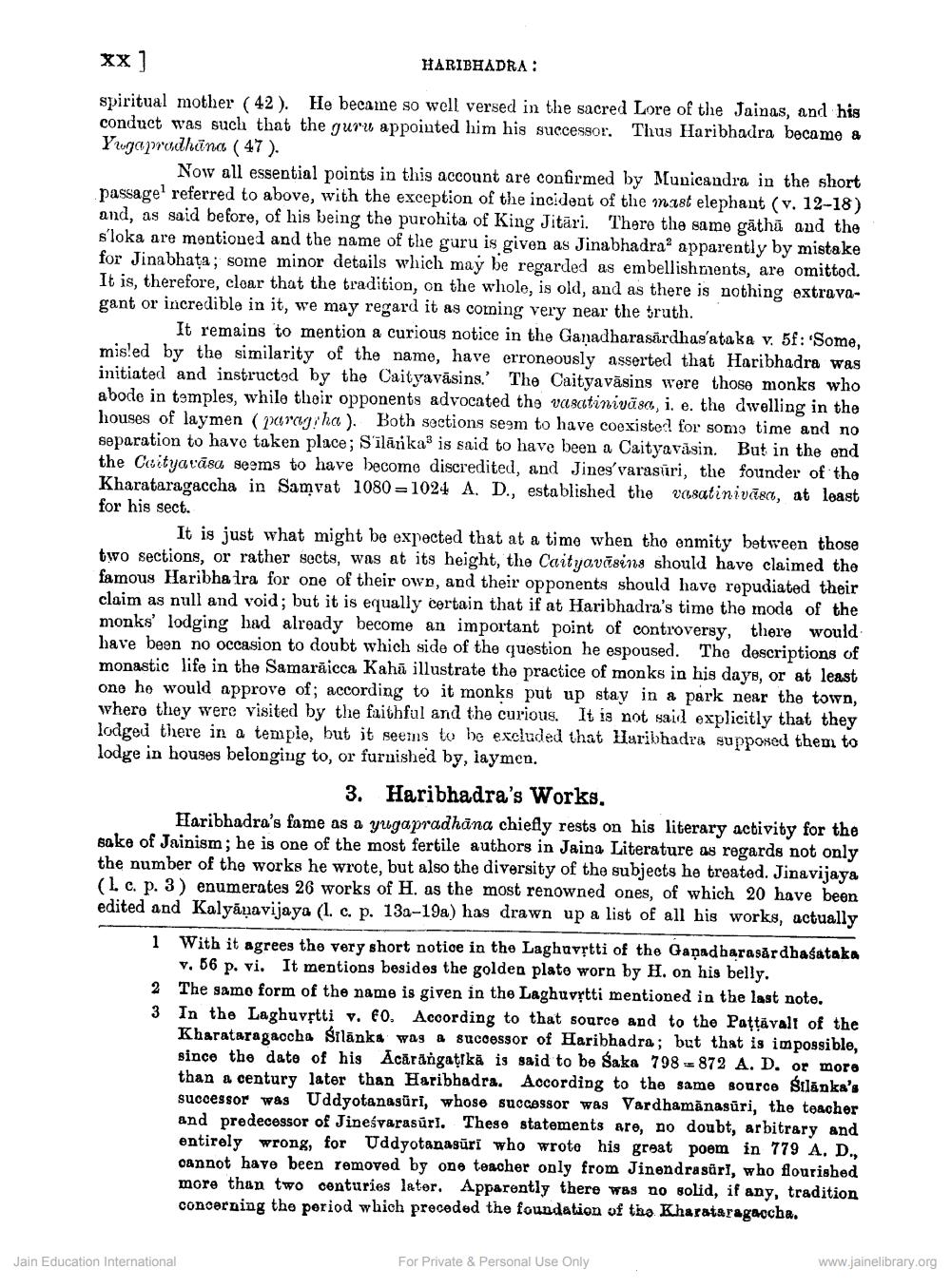________________
xx]
HARIBHADRA:
spiritual mother (42). He became so well versed in the sacred Lore of the Jainas, and his conduct was such that the guru appointed him his successor. Thus Haribhadra became a Yogapradhana (47).
Now all essential points in this account are confirmed by Municandra in the short passage' referred to above, with the exception of the incident of the mast elephant (v. 12-18) and, as said before, of his being the purohita of King Jitari. There the same gatha and the s'loka are mentioned and the name of the guru is given as Jinabhadra2 apparently by mistake for Jinabhats; some minor details which may be regarded as embellishments, are omitted. It is, therefore, clear that the tradition, on the whole, is old, and as there is nothing extravagant or incredible in it, we may regard it as coming very near the truth.
It remains to mention a curious notice in the Ganadharasärdhas'ataka v. 5f: 'Some, misled by the similarity of the name, have erroneously asserted that Haribhadra was initiated and instructed by the Caityavasins' The Caityavasins were those monks who abode in temples, while their opponents advocated the vasutinivasa, i. e. the dwelling in the houses of laymen (paragrha). Both sections seem to have coexisted for some time and no separation to have taken place; Silika" is said to have been a Caityavasin. But in the end the Cityardsa seems to have become discredited, and Jines'varasiri, the founder of the Kharataragaccha in Samvat 1080-1024 A. D., established the satiniven, at least for his sect.
It is just what might be expected that at a time when the enmity between those two sections, or rather sects, was at its height, the Caityandsins should have claimed the famous Haribha lra for one of their own, and their opponents should have repudiated their claim as null and void; but it is equally certain that if at Haribhadra's time the mode of the monks' lodging had already become an important point of controversy, there wouldhave been no occasion to doubt which side of the question he espoused. The descriptions of monastic life in the Samaraicca Kahu illustrate the practice of monks in his days, or at least one he would approve of; according to it monks put up stay in a park near the town, where they were visited by the faithful and the curious. It is not said explicitly that they lodged there in a temple, but it seems to be excluded that Haribhadra supposed them to lodge in houses belonging to, or furnished by, laymen.
3. Haribhadra's Works,
Haribhadra's fame as a yugapradhana chiefly rests on his literary activity for the sake of Jainism; he is one of the most fertile authors in Jaina Literature as regards not only the number of the works he wrote, but also the diversity of the subjects he treated. Jinavijaya (1. c. p. 3) enumerates 26 works of H. as the most renowned ones, of which 20 have been edited and Kalyanavijaya (L e. p. 13a-19a) has drawn up a list of all his works, actually
1 With it agrees the very short notice in the Laghuvṛtti of the Ganadharasardhasataka v. 56 p. vi. It mentions besides the golden plate worn by H. on his belly.
2 The same form of the name is given in the Laghuvṛtti mentioned in the last note. 3 In the Laghuvṛtti v. 60. According to that source and to the Pattavalt of the Kharataragaccha Silanks was a successor of Haribhadra; but that is impossible, since the date of his Acarängaṭtka is said to be Saka 798-872 A. D. or more than a century later than Haribhadra. According to the same source Silanka's successor was Uddyotanasüri, whose successor was Vardhamanasuri, the teacher and predecessor of Jinesvarasuri. These statements are, no doubt, arbitrary and entirely wrong, for Uddyotanasuri who wrote his great poem in 779 A. D., cannot have been removed by one teacher only from Jinendrasürl, who flourished more than two centuries later. Apparently there was no solid, if any, tradition concerning the period which preceded the foundation of the Kharataragacha.
Jain Education International
For Private & Personal Use Only
www.jainelibrary.org




